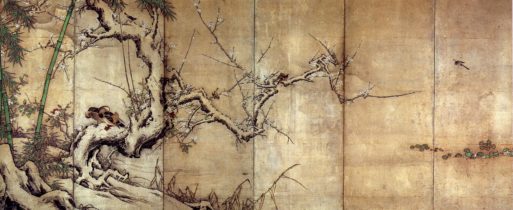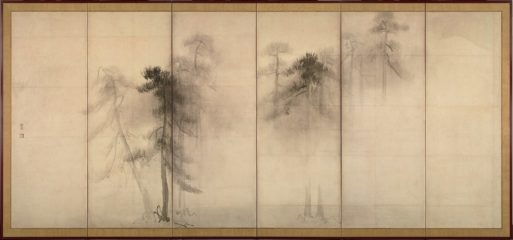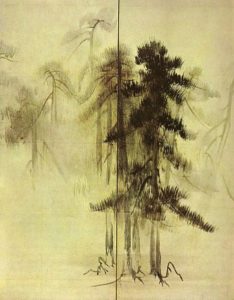
Hasegawa Tōhaku’s “Birds and Flowers’
Credit: Wikimedia.org
Known as one of the greatest painters in Japanese history, Hasegawa Tōhaku has influenced countless artists over the centuries. He is famous for his simple, almost reserved painting style; Hasegawa Tōhaku’s landscapes are all deeply serene and minimalist in nature. However, while the painter is most revered for his beautiful, calming landscapes, many of these works contain hidden musings on longevity and death. If you look carefully at some of his most popular paintings, you’ll see that the artist expresses a complex set of emotions that may not be obvious upon first glance.
One of the best examples of this mortality theme in Hasegawa Tōhaku’s landscapes is in “Birds and Flowers.” As your eyes move from left to right, each painted panel becomes more sparse. In the far left panel, Tōhaku paints a dense forest scene that is absolutely teeming with life. There are large swaths of green shrubbery, sturdy bamboo stalks and prickly pine needles growing in every direction.
But as he moves to the next panel, the scene becomes less bustling. He depicts a pair of sleeping ducks balanced on top of a thick tree branch. In the panels that follow, we see the branch grow thinner and thinner, with fewer green leaves. In the final two panels of the painting, the tree branch ends, and a small bird takes flight.

“Pine Trees”
Credit: Wikimedia.org
This piece can be interpreted as a microcosm of life and death. When looking at the painting from left to right, it shows the slow transformation from vibrancy and vitality to the more brittle, frail scene of the bird leaving the final branch. Like many of Tōhaku’s works, the lines between the beginning and the end of the painting are somewhat blurred; both life and death coexist simultaneously in his works.
Another example of the transition from life to death is in Hasegawa Tōhaku’s landscape “Pine Trees.” In this almost surreal work, the artist depicts two pine trees, which are surrounded by ghosts of the past and the future. We see the darker, bolder trees as they currently are, but in the background, we can also see very light brushstrokes of that same tree as it loses branches over time. It’s as if the entirety of the tree’s life is taking place right in front of us, all at once. The lines between life and death are quite literally blurred, and it’s difficult to know which tree exists right now, in the present moment.

Credit: Wikimedia.org
In Japan, pine trees symbolize powerful ideas around vitality, fertility and longevity. In fact, during New Year’s celebrations, many people place pine tree branches at their doorsteps to represent good fortune and prolonged life. In Hasegawa Tōhaku’s landscapes, these pine trees take on a similar meaning. They are a metaphor for life, and their slow and continuous decay is in turn a metaphor for inevitable death. Yet in Tōhaku’s world, this isn’t something to fear. Instead, it is an aspect of life that must be accepted as it is.
Hasegawa Tōhaku’s landscapes remind us of the beauty and power of nature. As we gaze at his paintings, we remember that life cycles are unavoidable, and that there can be beauty in this constant pattern of growth and decomposition.

 Exploring Themes of Life and Death in Hasegawa Tōhaku’s Landscapes
Exploring Themes of Life and Death in Hasegawa Tōhaku’s Landscapes


 John Mulaney’s “Funeral Planning” on Netflix: No Real Plan
John Mulaney’s “Funeral Planning” on Netflix: No Real Plan

 Composting Bodies Is Now Legal in a Dozen States
Composting Bodies Is Now Legal in a Dozen States














